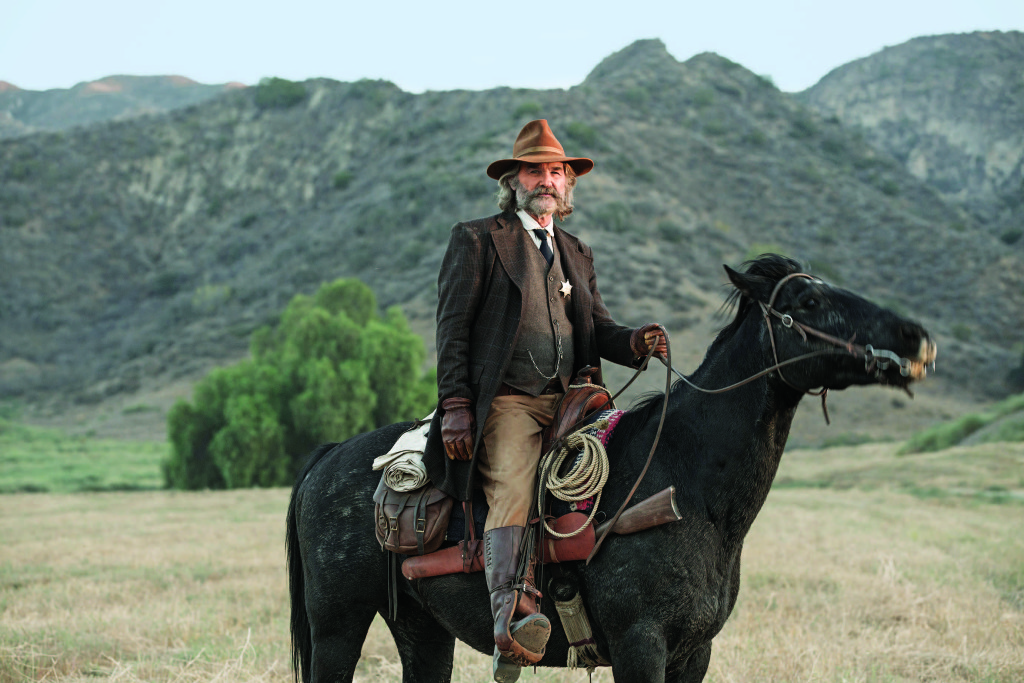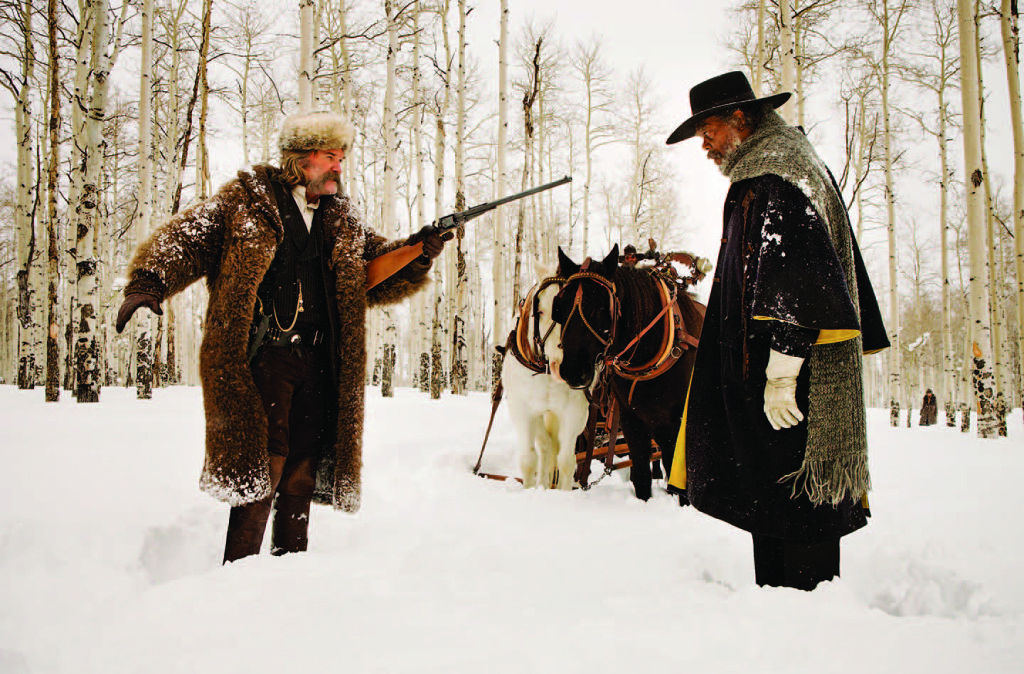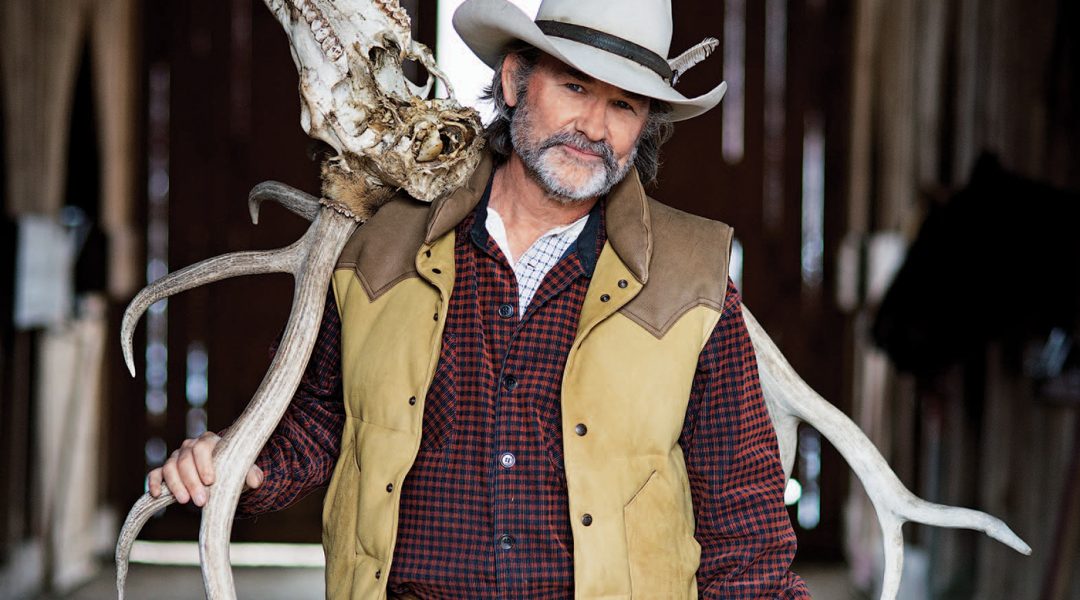From Tombstone’s Wyatt Earp to Bone Tomahawk’s cannibal-wrangling sheriff, this western veteran isn’t afraid of a challenge.
To say Kurt Russell’s a busy guy would be an understatement. Just back from 10 days at his ranch in Old Snowmass, Colorado, where he was unwinding with family and supervising his cattle operation after recently wrapping three back-to-back movies, he’s on the phone from his home in Pacific Palisades, California, for what will turn out to be a lengthy and leisurely conversation. During it he’ll go from enthusiasm to enthusiasm, showing no fatigue from a schedule that would level a man half his 64 years.
With a hearty “How the heck are ya?” Russell dives in, his energy never flagging as he discusses his movie career, his expanding cattle business in Colorado, his serious winemaking in Central California — and a revised outlook that has him determined to enjoy the fruits of his labors (and bottlings) a whole lot more.
The latest slew of Russell screen releases includes October’s Bone Tomahawk, a graphic western in which he sheriffs through the Old West on a rescue mission that pits his posse against cannibalistic cave dwellers. Then there’s December’s The Hateful Eight, a Quentin Tarantino western that has Russell’s bounty hunter bringing a murderess to justice — if they survive holing up among strangers during a blizzard. Fans have been like kids surveying the loot under the Christmas tree waiting for Bone Tomahawk, but fans and critics alike are itching to unwrap the really big present, The Hateful Eight.
But let’s open Bone Tomahawk first, shall we? You might wonder how novelist and first-time director S. Craig Zahler convinced the accomplished actor to venture away from the picturesque Santa Rita Hills vineyard where he produces his wines to make his first western since 1993’s Tombstone — one with settler-kidnapping cannibals, no less. Turns out, the story was intriguing enough to hook him from the start.
“It was one of the best scripts I’d read in years, even though the story is a bit strange,” Russell says. “Set in the historic West, this story is really different, taking place somewhere between Indian Territory and the prehistoric troglodyte world.”
Say what? Although not exactly a sci-fi film, Bone Tomahawk, incorporates an ancient cave-dwelling civilization into its historic Wild West, one that practices cannibalism and engages in pagan rituals. Their Stone Age weapons are crafted from bone and rock, and they live in deep caves perched high upon rocky precipices.
“The audience will need to believe that they don’t know where they are, just like the people in the movie,” Russell says. “All I’m going to say right now is that three of the characters are kidnapped and taken several hundred miles away from this remote little Western town, and we have to find them. This is a location that even the Native Americans in the area don’t travel into.”

Russell, who plays the role of Sheriff Franklin Hunt, leads the all-star cast, which includes Patrick Wilson (Insidious, Angels in America, Matthew Fox (Lost, Party of Five), and Richard Jenkins (Six Feet Under, The Visitor). But he didn’t just take the lead in front of the camera — he committed to the vision of the project and stuck with it through its financing obstacles.
It comes as no surprise that Russell’s the kind of guy who sticks to his guns and goes all in, whether it’s winemaking (his latest great passion) or moviemaking. Which might be why his latest character appealed so much to the versatile actor. In The Hateful Eight — Quentin Tarantino’s follow-up to his acclaimed antebellum spaghetti western, Django Unchained — Russell plays John “The Hangman” Ruth, a snappily dressed, entrepreneurial bounty hunter who ends up stuck in a room with his prisoner and various other characters of dubious background and intent. Unlike Wyatt Earp, this guy’s no hero — or is he?
Tarantino’s stated goal with the film was to get rid of the white-hatted heroes. Instead, he wanted to put all the black (and furry) hats in a room and see what happened. And to do that, to ensure that the audience won’t know from the get-go who will emerge victorious, he needed an ensemble cast. “This is a movie where [bigger movie stars] wouldn’t work. It needs to be an ensemble where nobody is more important than anybody else,” Tarantino said in an interview with Vulture.
The film’s influences were similarly democratic. “It’s less inspired by one western movie than by Bonanza, The Virginian, [The] High Chaparral,” Tarantino noted at Comic-Con. “Twice per season, those shows would have an episode where a bunch of outlaws would take the lead characters hostage. They would come to the Ponderosa and hold everybody hostage, or go to Judge Garth’s place — Lee J. Cobb played him — in The Virginian and take hostages. There would be a guest star like David Carradine, Darren McGavin, Claude Akins, Robert Culp, Charles Bronson, or James Coburn.
“I don’t like that story line in a modern context, but I love it in a western, where you would pass halfway through the show to find out if they were good or bad guys, and they all had a past that was revealed. I thought, What if I did a movie starring nothing but those characters? No heroes, no Michael Landons. Just a bunch of nefarious guys in a room, all telling back stories that may or may not be true. Trap those guys together in a room with a blizzard outside, give them guns, and see what happens.”
Filmed principally in Colorado on the Schmid Ranch near Telluride, The Hateful Eight takes place in post-Civil War Wyoming, where the titular eight try to find shelter during a horrendous snowstorm but get involved in a plot of betrayal and deception. The location was just a three-hour drive from Russell’s ranch outside of Aspen, which allowed him to travel home during the shoot.
“The weather was great there, and we were able to get the snow we needed for the blizzard scenes,” Russell says. “However, most of the film takes place inside a confined space — both in Colorado as well as two months in Los Angeles.”
Locked together in a one-room stagecoach stopover on a mountain pass, the characters feature a killer collection of genre types, including Jennifer Jason Leigh as captured outlaw Daisy Domergue, “The Prisoner”; Bruce Dern as Gen. Sanford Smithers, “The Confederate”; Walton Goggins as supposed lawman Chris Mannix, “The Sheriff”; Michael Madsen as Joe Gage, “The Cow Puncher”; Samuel L. Jackson as Union Maj. Marquis Warren, “The Bounty Hunter”; and, of course, Russell as brutish bounty hunter John Ruth, “The Hangman.”
Perhaps Jackson’s character, Maj. Warren, best describes Ruth, whose motives become the catalyst of the story: “They call him The Hangman. When the handbill says ‘dead or alive,’ the rest of us just shoot you in the back from up on top of a perch somewhere and bring you in dead over a saddle. But when John Ruth, ‘The Hangman,’ catches you, you hang.”

Russell agrees with the description: “That, in a nutshell, is not only the crux of who John Ruth is, but what and why the things that take place and are acted upon in this movie happen. John Ruth is that kind of individual. The other bounty hunters would just shoot the ‘wanted dead or alive’ prisoner in the back of the head. With Ruth that would not happen. He believes that the accused should get their day in court, so his mental state is the reason this story plays out.
“Ruth believes in the process — that the accused should stand trial for their crimes, and when found guilty, dance at the end of a rope. He’s a terribly rough guy, who’s seen a lot and has no manners at all, and yet has this strange relationship with the woman who is his bounty.” Describing their relationship as a type of Stockholm syndrome, Russell explains that Daisy forms an emotional bond with her captor. “They are literally attached to each other for a week, and he never takes that handcuff off.” The result, Russell says, is that Daisy and Ruth become something of a team as they wait out the blizzard.
“[Ruth has] a tremendous level of instinct, but without knowing it, he’s not the sharpest tool in the shed. He’s older now, has drunk a lot of tequila, and is definitely an iconic-looking Western figure with a mustache so big, it’s like wearing another human being.”
As with most of Tarantino’s trademark characters, there are depths to plumb and surprises to reveal. “Ruth is very fair, and when the world is not fair to him he can be extremely offended and gets his feelings hurt,” Russell says. “You don’t see that until later in the movie, and the way you see it is devastating. This guy has a whole different side to him, as we all do.”
Scored by spaghetti western great Ennio Morricone, who also did some of the music for Tarantino’s Django Unchained, the film was shot by three-time Oscar winner for best cinematography Robert Richardson. Using 70mm film — a wide high-resolution format used mostly in the ’50s and ’60s for films such as Lawrence of Arabia and Ben-Hur — Tarantino created a vivid cinematic space filled with a fascinating assortment of people playing out their individual stories.
“It was very important to Quentin that he shoot this particular film in 70mm,” Russell says. “If other directors decide to film in 70mm in the future, it will be thanks in part to him.”
With all of its creative firepower, The Hateful Eight seems teed-up for critical acclaim. But the movie very nearly didn’t get made. Tarantino abruptly and brashly decided to shelve the film in January 2014, when, after confidentially giving the script to a small group of actors, one of their agents dispersed it all over Hollywood. Several months after the infuriating leak, an incensed Tarantino was still threatening to kill the movie completely and release the story only as a novel. But then a star-studded script reading for charity was so successful and inspiring, he changed his mind, and The Hateful Eight was once again back on track.
Russell, for one, couldn’t be more pleased. “Making The Hateful Eight might have been the greatest experience I’ve ever had as an actor, working with Quentin and the other actors, in terms of the day-to-day work and having fun,” he says. “Quentin created such a fabulous environment for you to live out the dream of the circus that you thought you were joining. He loves doing what he does so much, he can’t help but cinematically capture that feeling, making us feel the same way. You have this merry band of people all heading down the same track with a terrific script to work with. It was the kind of situation that any actor would want to be a part of.”
The Hateful Eight isn’t Russell and Tarantino’s first rodeo together: They previously collaborated on Death Proof (2007), part of a double feature collaboration with director Robert Rodriguez that was released as Grindhouse. Tarantino said in an interview with Entertainment Weekly that he cast Russell as the killer stunt driver because “for people of my generation, he’s a true hero ... but now, there’s a whole audience out there that doesn’t know what Kurt Russell can do. When I open the newspaper and see an ad that says ‘Kurt Russell in Dreamer,’ or ‘Kurt Russell in Miracle,’ I’m not disparaging these movies, but I’m thinking: When is Kurt Russell going to be a badass again?”
The admiration is mutual. Russell compares working with Tarantino to his longtime collaboration with director John Carpenter, with whom he worked for more than a decade on Elvis (1979), The Thing (1982), Big Trouble in Little China (1986), and fan-favorite Escape From New York (1981). Russell offers not a superlative but a simile.
“[Both of them] have truth and value. They believe in the actors they work with, and in turn the actors believe in them. It’s a little bit like being on a pirate ship with a badass captain. You’re not there to question them but to have some fun and share the loot.”
From the November/December 2015 issue














